Introduction:
Large data sets are analyzed using data analytics to reveal patterns, trends, and insights that might help decision-making. Data analytics has become a more crucial tool for enterprises and individuals due to the growth of big data. We’ll go through the fundamentals of data analytics in this beginner’s guide and advise getting started on your projects.
Data analytics: What is it?
Large data sets are analyzed using data analytics to find patterns, trends, and insights that might help decision-making. It comprises using statistical and computational techniques for data analysis and information extraction. A wide range of industries, including business, healthcare, finance, and marketing, can benefit from data analytics. By analyzing data, companies may enhance their operations, make better decisions, and get a competitive advantage in their sector.
Data analytics types.
Data analytics comes in three primary flavors: descriptive, predictive, and prescriptive. The goal of descriptive analytics is to explain what happened and why. In contrast, predictive analytics aims to forecast upcoming events or trends using mathematical models and machine learning techniques. The next stage is narrow analytics, which makes action recommendations based on the knowledge gleaned from descriptive and predictive analytics. Each analytics has distinct advantages and may be applied in many ways to help decision-making.
Data gathering and cleansing.
Data collection and cleaning are necessary before you can begin analyzing it. This entails locating the data sources, figuring out what information applies to your study, and ensuring the data is reliable and comprehensive. Data cleaning entails eliminating any mistakes, discrepancies, or duplicates from the data. This phase is essential since the caliber of your data will determine how well your analysis turns out. Data scraping tools, data wrangling software, and data visualization tools are just a few of the tools and methods that may assist with data collecting and cleaning.
Applying statistical analysis to data.
It’s time to begin analyzing your data once you’ve collected and cleansed it. In data analytics, statistical techniques are frequently used to categorize patterns, connections, and trends in the data. These techniques include inferential statistics, which in short employs probability theory to make predictions and draw inferences about the data, and descriptive statistics, which utilizes metrics like mean, median, and standard deviation to summarise the data. You may execute these studies with various statistical software programs, including R and Python.
Presenting and visualizing data.
You must clearly and succinctly communicate your results once you have analyzed the data. Data visualization, which entails producing graphs, charts, and other visual representations of your data, is one efficient method for accomplishing this. Use this to categorize patterns and trends that might not be immediately seen from looking at the raw data. Excel, Tableau, and Google Charts are just a few technologies that may be used to create data visualizations. It’s crucial to consider your audience while presenting your facts and to adjust your presentation to suit their demands and degree of comprehension.
Description in Meta
Data analytics is a potent tool that both people and corporations may use. This indispensable manual will assist you in grasping the fundamentals and in starting your projects.
Also read:- Helpful SEO Insights To Study From Google Analytics
